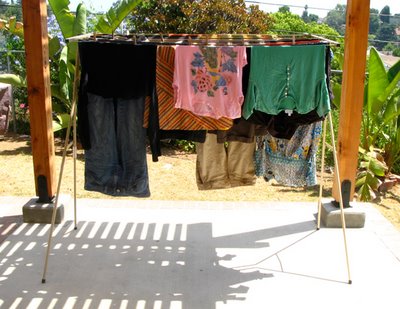Summer Laundry
 Earlier this summer, I found Mrs. Pegg's Handy Line. It's a collapsible freestanding clothesline big enough to handle queen size sheets and easy to set up. Those are the full length of my jeans hanging there. I've already used it half a dozen times, and honestly, it's very little hassle. Those legs just fold up parallel to the flat line. I keep it in the garage where I plan to hang it so that it's not just leaning against the wall.
Earlier this summer, I found Mrs. Pegg's Handy Line. It's a collapsible freestanding clothesline big enough to handle queen size sheets and easy to set up. Those are the full length of my jeans hanging there. I've already used it half a dozen times, and honestly, it's very little hassle. Those legs just fold up parallel to the flat line. I keep it in the garage where I plan to hang it so that it's not just leaning against the wall.Having dried my clothes outdoors last summer was great because clothes dried quickly sometimes in an hour, but I reverted back to the electric dryer because 1. I could not fit two loads of laundry or bed sheets on the smaller stand I had and 2. I got lazy in the cooler months not wanting to go out when it was cold.
This summer, after learning the electric dryer uses as much electricity as your refrigerator in one year, I was really ready to make it happen. I researched a bunch of options, and eventually opted for this. Now, I have my big line and my old little line! To solve the problem of the cooler months, I tested out my set up indoors. I actually found it even more convenient because I could wash in the early evening, and then leave it to dry till the next day, maybe longer when it is actually January, but that's okay.
Took a little bit of time to get my family to sacrifice this luxury, but when I found out that two of my neighbors have been doing it for years and my German neighbor does not even own an electric dryer, I had to try. The more I thought about it, the more I realized that clothes are line dried everywhere else in the world but here. It is done in the Philippines for sure, but I also remember them doing it in Tokyo for our clothes in the middle of winter! We had no excuse.
Mrs. Pegg's Handy Line wasn't cheap, but so far it's been worth it.
update: I recently read that air drying damp clothes indoors cools or lowers the temperature of a room. This is great for spring, summer, when don't mind a cooler room, but probably not good during the winter months when you'd rather it be warm. The dampness cools the room making the heater work harder to warm it up. The extra energy used to compensate for the dampness can be the same as the energy you would have used if you had used the electric dryer. So in cooler months, it seems best to dry outdoors, maybe in the garage, or a room that is not being heated. Information from How to Live a Low-Carbon Life by Chris Goodall.
Labels: green living


1 Comments:
hi em!
i just love the picture of your clothes hanging out to dry in the hot LA sun! I wish we were there to see it all!
Post a Comment
<< Home